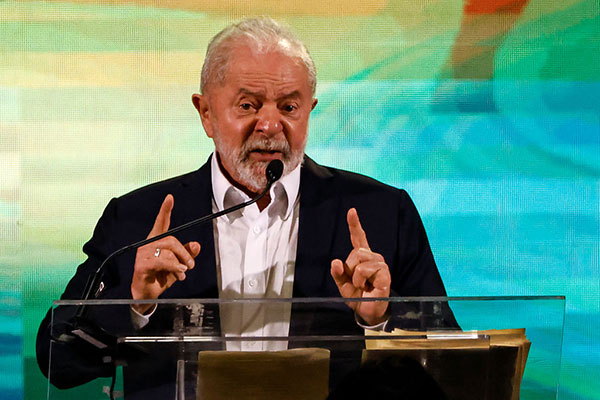Risks and rewards of backing these booming funds
14th June 2022 10:24
by Ceri Jones from interactive investor
Ceri Jones explains the drivers behind this region enjoying one of its characteristic periods of blistering outperformance.

Latin America has been one of the best-performing regions so far in 2022, benefiting from soaring commodity prices, a trend that has been further reinforced by the conflict in Ukraine.
This heterogeneous group of countries exports a broad range of commodities, from oil (Brazil and Colombia) to industrial and precious metals (Brazil, Chile, Mexico, Peru) and agricultural products (Argentina, Brazil, Chile, Mexico). Consequently, most of Latin America has seen a sharp improvement in its terms of trade and with limited economic ties to Russia, the region is relatively insulated from the conflict.
These markets tend to be cyclical, alternatively running very hot or very cold, in flurries. Both 2020 and 2021 were dire years, in contrast to the stock markets of Western nations, where fiscal and monetary stimulus helped propel gains.
As the Ukrainian conflict grinds on, commodity shortages are thrusting the region into one of its characteristic periods of blistering outperformance.
- BRICs: is the famous investment acronym no longer fit for purpose?
- Ian Cowie: this ‘too hot to touch’ trust is now booming again
- 25 equity investment trusts yielding more than 4%
Since the start of 2022 (to 10 June), actively managed funds specialising in the Latin America region have produced returns of 14% on average. Leading the way is Schroder ISF Latin American, up 22.8%, followed by Barings Latin America, ASI Latin American Equity, and BlackRock GF Latin America, with respective returns of 20.8%, 16.6% and 15.4%.
Topping the table for passive strategies with returns of 19.3% and 18.5% are HSBC MSCI Emerging Markets Latin America ETF (LSE:HMLD) and iShares MSCI Emerging Market Latin America ETF (LSE:LTAM).
Commodities are a good hedge against inflation, and this has attracted investors concerned about the economic backdrop and falling asset prices across traditional equity and bond markets. Higher inflation will push the Federal Reserve to raise interest rates in the US, but this time around, Latin American central banks have been swift to react and have been tightening for some time. For example, Brazil has hiked rates by 10.75% over the past 14 months. This should leave these countries less vulnerable and better positioned for higher rates than in previous cycles.
“Rising commodity prices have driven Latin American stock markets higher since the start of the year, in contrast to many of their emerging market peers and this is also having an impact on the region’s currencies, which have performed well after a difficult 2021,” says Ed Kuczma, co-manager of the BlackRock Latin American (LSE:BRLA) investment trust.
He adds: “This is generally good for Latin American markets and we’ve seen the prices of oil, soybeans and iron ore, Brazil’s main commodity exports, increase since the start of the year. There is also a strong outlook for pulp and paper, with resilient demand.
“A lot of new capacity has been delayed as a result of the pandemic and disruption in supply pushing up prices. With Latin American companies among the lowest cost pulp and paper producers in the world, this will give them a significant advantage at a time of rising prices.”
- The fund and investment trust sectors with the highest yields
- Five tips to cope in a bear market
- Topping up trusts in a ‘cheap’ region that’s out of favour
The region’s stocks also remain relatively cheap at just seven times forward earnings.
Brazil is widely seen as most interesting market, and State-owned Brazilian oil company Petrobras (NYSE:PBR.A) for example is on a P/E of just five times.
Earnings momentum is also strong. “Already this year earnings estimates have been revised 27% and 18% higher for 2022 and 2023, respectively,” says Thomas Smith, manager of the Liontrust Latin America fund. “This comes on top of 2022 earnings estimates being revised 21% higher over the course of last year and stands in stark contrast to the negative earnings momentum seen in the broader emerging markets.”
Bias towards value shares
Another attraction is Latin America markets are stuffed with value companies, which have enjoyed a resurgence in demand, and are relatively light on growth and tech stocks which have fallen from favour. Investors with portfolios that are still heavily weighted to growth stocks might find that adding specialist funds or trusts helps to balance their exposure.
“Even after the recent rally, the Latin American indices are under-owned and under-valued and benefiting from a global move towards value stocks which favour areas such as energy and financials,” says Kuczma.
“Around 60% of Brazil’s Ibovespa is made up of stocks often classified as value, mostly financials and commodities, and this compares with around 15% in the S&P 500.
“Other Latin American countries such as Chile, Colombia and Peru also have a strong value bias.”
The region’s markets are notoriously volatile, however, and carry material risks. First, there is the prospect of weakening demand for commodities, owing to China’s Covid lockdown and/or a general economic slowdown if the conflict in Ukraine damages global growth more than expected.

Political risks par for the course
The other main risks are political. “As is often the case in Latin America, domestic events exacerbate global trends,” adds Smith.
“As the macro backdrop has improved with sharply higher commodity prices, so too the political landscape in Brazil has become more constructive. Former President Lula (pictured above) is leading the polls for October’s presidential election and is looking more business-friendly than previous Workers’ Party administrations.
“He has already distanced himself from the far left of his party and left little doubt that he will adopt pragmatic, centrist policies if re-elected.”
The structural problems run deep, however, and only an overhaul of government policy will produce a genuine turnaround in long-term growth.
- 15 cheap shares value fund managers are backing
- The great investment strategies: value investing
- Five tips to cope in a bear market
“The underlying strengths of the economy are not as diverse as they ought to be,” says Charles Bond, fund manager, Asian and emerging market equities at Invesco. “Former emerging markets, such as Taiwan and South Korea, have been able to grow the pace of manufacturing for export...but Brazil has failed to make the transition and its manufacturing exports have declined as a percentage of GDP over the last 10 years.
“There has been no enactment of proper reforms of the Labour market or tax system. Many Asian countries have high investment rates, but Brazil has had a deficit for the last decade, compounded by tax problems. These are cyclical markets that do not share the same drivers of economic growth as parts of Asia.”
Brazil imposes local content rules, for example. This means manufacturers need to source a certain percentage of their parts from within the country. Too often this is unrealistic as the parts may not be manufactured nearby, or they may be too expensive as the local supplier lacks scale, and bottlenecks develop.
Active funds the best route for this region
For the private investor, Latin America is very much a market to navigate by active management rather than passively via an index or tracker fund. Passive funds have high exposure to political risks such as businesses that are state-owned, and perhaps are overexposed to well established large businesses with not much growth left in them.
There is also an argument for using an unconstrained, free-ranging emerging market equity fund to play these markets as the manager can move in and out with ease.
Now looks as good a juncture as any to get into Latin America, and potentially take advantage of a flurry of outperformance, but over the long term it is as well to remember that these markets tend to lag their competitors.
Tiago Rodrigues, fund manager of the abrdn Latin American Equity fund, who is based in São Paulo, points out: “The presidential election in Brazil, uncertainty in Chile around constitutional changes and a general slowdown in economic activity since rates were hiked up are clearly risks, but our view is that the markets remain very much discounted and this is true across asset classes and sectors.
“A high level of risk has been priced into valuations and the region is at a compelling point, especially in view of the recent sell off in global markets. Before the sell off, we thought valuations were attractive, but they are even more attractive now…because the region is ahead of the rate curve.”
These articles are provided for information purposes only. Occasionally, an opinion about whether to buy or sell a specific investment may be provided by third parties. The content is not intended to be a personal recommendation to buy or sell any financial instrument or product, or to adopt any investment strategy as it is not provided based on an assessment of your investing knowledge and experience, your financial situation or your investment objectives. The value of your investments, and the income derived from them, may go down as well as up. You may not get back all the money that you invest. The investments referred to in this article may not be suitable for all investors, and if in doubt, an investor should seek advice from a qualified investment adviser.
Full performance can be found on the company or index summary page on the interactive investor website. Simply click on the company's or index name highlighted in the article.